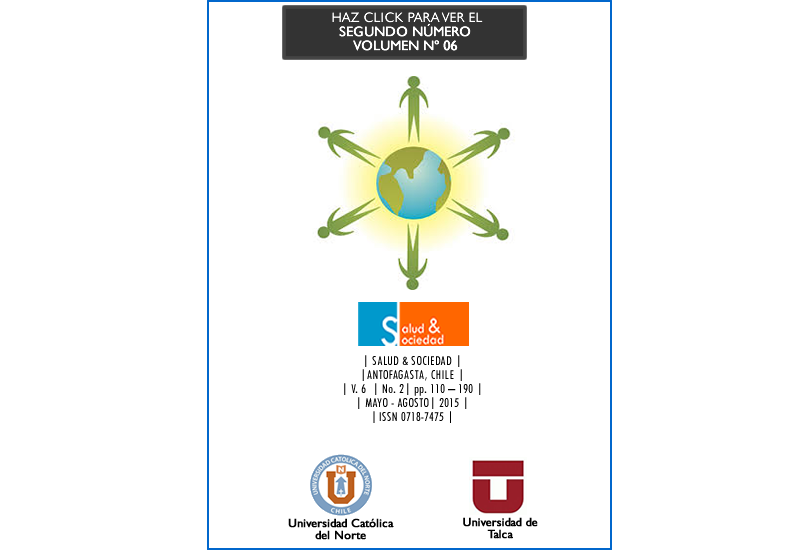Diferencias en satisfacción con la relación entre variables demográficas y religiosidad
DOI:
https://doi.org/10.22199/S07187475.2015.0002.00002Palabras clave:
Estado civil, religiosidad, satisfacción con la relación, sexo, Marital status, religiosity, satisfaction with the relationship, sex,Resumen
INTRODUCCIÓN: La tendencia central de la satisfacción con la relación y su asociación con variables poblacionales se suelen estimar usando muestreos no probabilísticos. OBJETIVOS: describir la distribución de la Escala de Valoración de la Relación (RAS) de Hendrick en población general de la ciudad de Monterrey, México; estudiar su asociación con variables demográficas y de religiosidad; especificar un modelo predictivo; y contrastar su invarianza entre ambos sexos. METODO: Se empleó un muestreo probabilístico, usando el método de rutas aleatorias, y se aplicó la RAS a 431 mujeres y 376 hombres. RESULTADOS:La distribución de la RAS presentó asimetría negativa. La RAS mostró diferencia entre personas casadas y en unión libre, pero no entre ambos sexos; correlacionó con el número de hijos, convicción religiosa, práctica religiosa, escolaridad, ingresos económicos y estatus laboral; y fue independiente de la edad y años de relación. Con buen ajuste e invarianza entre ambos sexos, estar casado, menor número de hijos y mayor práctica religiosa predijeron mayor satisfacción con la relación.CONCLUSION: la escala debe ser baremada por cuantiles, requiriendo baremos diferenciales por estado civil, pero no por sexo.Un modelo integrado sólo por variables demográficas y de religiosidad tiene capacidad predictiva pequeña.
INTRODUCTION: Central tendency of satisfaction with the relationship and its association with population variables tend to be measured by means of nonprobability sampling. OBJECTIVES: 1. Describe the distribution of Hendrick’s RAS in the general population of Monterrey city, Mexico. 2. Study the association of such distribution across demographic variables and religiosity. 3. Specify a predicting model for satisfaction with the relationship. 4. Contrast its invariance in both sexes. METHOD: A probability sampling was employed, using the random routes method. Also, the RAS was applied to 431 women and 376 men. RESULTS: The RAS distribution resulted in negative asymmetry. This scale registered differences between married couples and non-married couples, but not between sexes. It correlated with number of children, religious orientation, religious practice, school level, economic income and occupational status, but was independent from age and years of relationship. With invariance between both sexes, being married, less number of children and more religious practice predicted higher satisfaction with the relationship. CONCLUSION: The scale should be divided by quantiles, requiring different scales for marital status but not for sex. An integrated model consisting only of demographic variables and religiosity has a small predicting capacity.
Descargas
Referencias
American Psychological Association. (2002). Ethical principles of psychologists and code of conduct. American Psychologist, 57, 1060-1073. doi:10.1037/0003-066X.57.12.1060
Armenta, C., Sánchez-Aragón, R., & Díaz Loving, R. (2014). Efectos de la cultura sobre las estrategias de mantenimiento y satisfacción marital. Acta de Investigación Psicológica, 4, 1572-1584. doi:10.1016/S2007-4719(14)70394-1
Bodenmann, G., Ledermann, T., & Bradbury, T. N. (2007). Stress, sex, and satisfaction in marriage. Personal Relationships, 14, 551-569. doi:10.1111/j.1475-6811.2007.00171.x
Botella, J., & Sánchez, J. (2015). Metaanálisis en ciencias sociales y de la salud. Madrid: Síntesis. Britt, S., Grable, J. E., Goff, B. S. N. & White, M. (2008). The influence of perceived spending behaviors on
relationship satisfaction. Financial Counseling and Planning, 19, 31-43.
Byrne, B. M. (2010). Structural equations with AMOS: Basic concepts, applications, and programming (2nd ed.). New York, NY: Routledge.
Carlson, R. G., Barden, S. M., Daire, A. P., & Greene, J. (2014). Influence of relationship education on relationship satisfaction for low-income couples. Journal of Counseling & Development, 92, 418-427. doi:10.1002/j.1556-676.2014.00168.x
Dellner, D. K. (2008). Pornography use, relationship functioning and sexual satisfaction: The mediating role of differentiation in committed relationships (Tesis doctoral). De la base de datos de ProQuest Dissertations & Theses (UMI No. 3335233).
Díaz-Loving, R., & Rivera-Aragón, S. (2002). La psicología del amor: Una visión integral de la relación de pareja. Ciudad de México: Miguel Ángel Porrúa.
Dinkel, A., & Balck, F. (2005). An evaluation of the German relationship assessment scale. Swiss Journal of Psychology, 64, 259-263. doi:10.1024/1421-0185.64.4.259
Ellis, P. (2010). The essential guide to effect sizes: Statistical power, meta-analysis, and the interpretation of research results. Cambridge: Cambridge University Press.
Fischer, R., & Milfont, T. L. (2010). Standardization in psychological research. International Journal of Psychological Research, 3, 88-96.
Glenwright, B. J., & Fowler, D. M. (2013). Implications of egalitarianism and religiosity on relationship satisfaction. Interpersona, 7, 215-226. doi:10.5964/ijpr.v7i2.137
Gonzaga, G. C., Campos, B., & Bradbury, T. (2007). Similarity, convergence, and relationship satisfaction in dating and married couples. Journal of Personality and Social Psychology, 93, 34-48. doi: 10.1037/0022-3514.93.1.34
Gottman, J. M., & Notarius, C. I. (2002). Marital research in the 20th century and a research agenda for the 21st century. Family Process, 41, 159-197. doi:10.1111/j.1545-5300.2002.41203.x
Hendrick, S. S. (1988). A generic measure of relationship satisfaction. Journal of Marriage and the Family, 50, 93-98. doi:10.2307/352430
Hendrick, S. S., Dicke, A., & Hendrick, C. (1998). The relationship assessment scale. Journal of Social and Personal Relationships, 15, 137-142.doi:10.1177/0265407598151009.
Hirschberger, G., Srivastava, S., Marsh, P., Cowan, C. P., & Cowan, P. A. (2009).Attachment, marital satisfaction, and divorce during the first fifteen years of parenthood. Personality Relationship, 16, 401-420. doi:10.1111/j.1475-811.2009.01230.x
Hoffmann, A. F., Stover, J. B., de la Iglesia, G., & Fernández, M. (2013). Correlaciones policóricas y tetracóricas en estudios factoriales exploratorios y confirmatorios. Ciencias Psicológicas, 7(2), 151-164.
Hsueh, A. C. Morrison, K. R., & Doss, B. D. (2009). Qualitative reports of problems in cohabiting relationships: Comparisons to married and dating relationships. Journal of Family Psychology, 23, 236-246. doi:10.1037/a0015364
Hunler, O. S., & Gencoz, T. (2005). The effect of religiousness on marital satisfaction: testing the mediator role of marital problem solving between religiousness and marital satisfaction relationship. Contemporary Family Therapy: An international Journal, 27, 123-136. doi:10.1007/s10591-004-1974-1
Instituto Nacional de Estadística, Geografía e Informática (2011). Panorama sociodemográfico de Nuevo León.Ciudad de México: INEGI. Recuperado el 22 de junio de 2015, de http://www.inegi.org.mx/prod_serv/contenidos/espanol/bvinegi/productos/censos/poblacion/2010/panora_socio/nl/Panorama_NL.pdf
Jackson, J. B., Miller, R. B., Oka, M., & Henry, R. G. (2014). Gender differences in marital satisfaction: A meta-analysis. Journal of Marriage and Family, 76, 105-129.doi:10.1111/jomf.12077
Kaplan, R. M., & Saccuzzo, D. P. (2009).Psychological testing: Principles, applications, and issues (7 ed.). Belmont, CA: Wadsworth.
Khan, A., & Rayner, G. D. (2003). Robustness to non-normality of common tests for the many-sample location problem. Journal of Applied Mathematics and Decision Sciences, 7(4), 187-206.doi:10.1155/S1173912603000178
Kim, H. K., Capaldi, D. M. & Crosby, L. (2007). Generalizability of Gottman and collegues’ affective process models of couples’ relationship outcomes. Journal of Marriage and Family, 69, 55-72.doi:10.1111/j.1741-3737.2006.00343.x
Lantz, B. (2013). The impact of continuity violation on ANOVA and alternative methods. Journal of Modern Applied Statistical Methods, 12(2), Article 6. Extraído de: http://digitalcommons.wayne.edu/jmasm/vol12/iss2/6
Maisel, N. C., & Karney, B. R. (2012). Socioeconomic status moderates associations among stressful events, mental health, and relationship satisfaction. Journal of Family Psychology, 26, 654-660. doi:10.1037/a0028901.
Malouffa, J. M., Schuttea, N. S., & Thorsteinssona, E. B. (2014). Trait emotional intelligence and romantic relationship satisfaction: A metaanalysis. The American Journal of Family Therapy, 42, 53-66. doi:10.1080/01926187.2012.748549
Moral, J. (2008). Validación de la Escala de Valoración de la Relación en población mexicana. Revista Electrónica de Metodología Aplicada, 13(1), 1-12. Recuperado de http://www.psico.uniovi.es/REMA/v13n1/vol13n1a1.pdf
O'Rourke, N., & Cappeliez, P. (2003). Intracouple variability in marital aggrandizement: Idealization and satisfaction within enduring relationships. Current Research in Social Psychology, 8(15), 206-225.
Olderbak, S., & Figueredo, A. J. (2009). Predicting romantic relationship satisfaction from life history strategy. Personality and Individual Differences, 46, 604-610. doi:10.1016/j.paid.2008.12.019
Sáenz, N. E. (2014). Modelo para la promoción del sexo seguro en parejas estables (Tesis de doctorado). Monterrey: Facultad de Enfermería, Universidad Autónoma de Nuevo León. Recuperado de http://eprints.uanl.mx/3983/1/1080253625.pdf
Sawilowsky, S. S., & Blair, R. C. (1992). A more realistic look at the robustness and type II error properties of the t test to departures from population normality. Psychological Bulletin, 111, 352-360. doi:10.1037/0033-2909.111.2.352
Twenge, J. M., Campbell, W. K., & Foster, C. A. (2003). Parenthood and marital satisfaction: A meta-analytic review. Journal of Marriage and Family, 65, 574-583. doi:10.1111/j.1741-3737.2003.00574.x
Wendorf, C. A., Lucas, T., Imamoglu, E. O., Weisfeld, C. C., & Weisfeld, G. E. (2011). Marital satisfaction across three cultures: does the number of children have an impact after accounting for other marital demographics? Journal of Cross-Cultural Psychology, 42, 340-354. doi:10.1177/0022022110362637
Descargas
Publicado
Número
Sección
Licencia
Los autores continúan como propietarios de sus trabajos, y pueden volver a publicar sus artículos en otro medio sin tener que solicitar autorización, siempre y cuando indiquen que el trabajo fue publicado originariamente en Revista Salud & Sociedad (ISSNe:0718-7475).



_(1).png)





